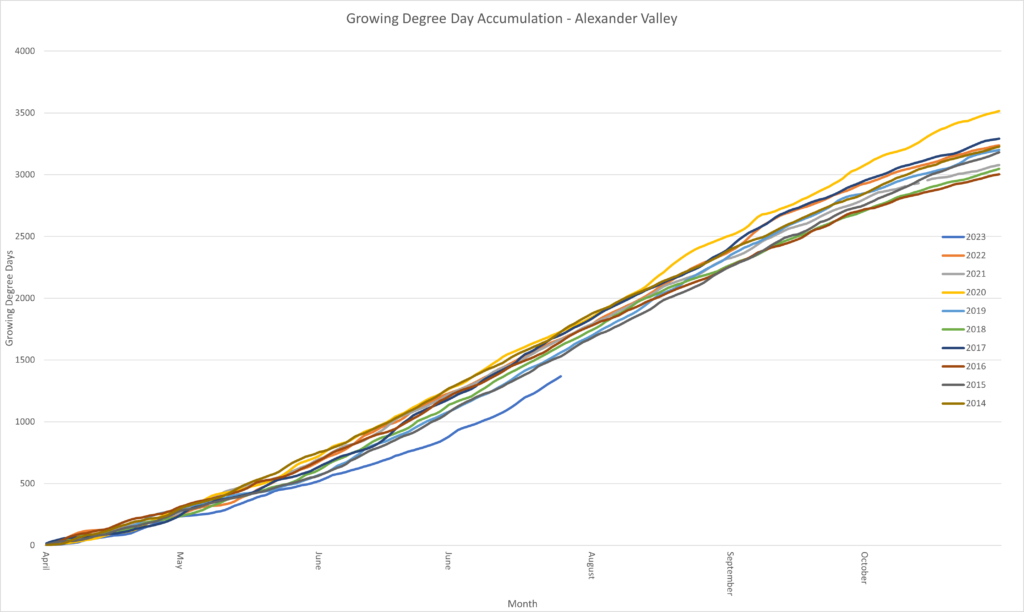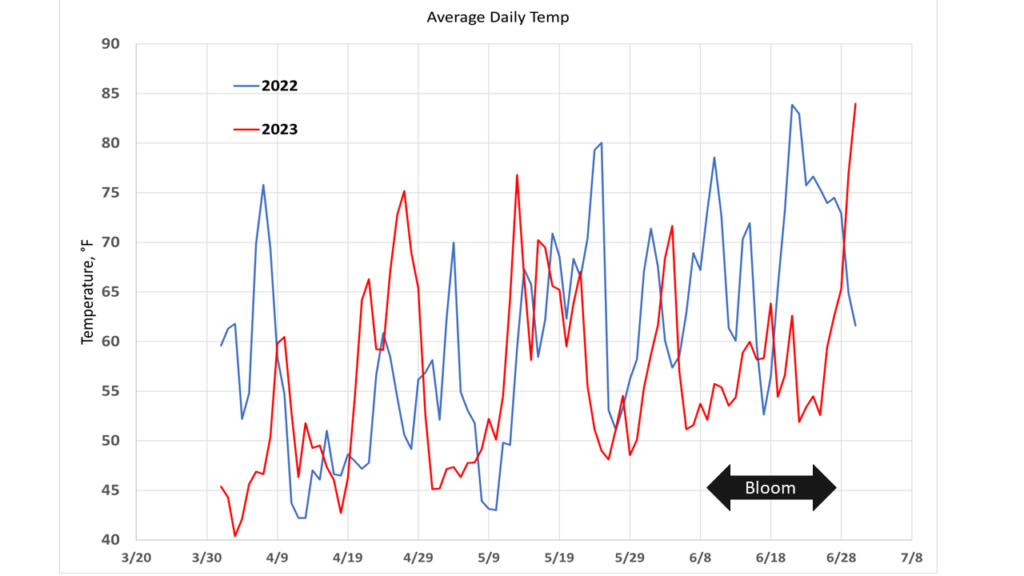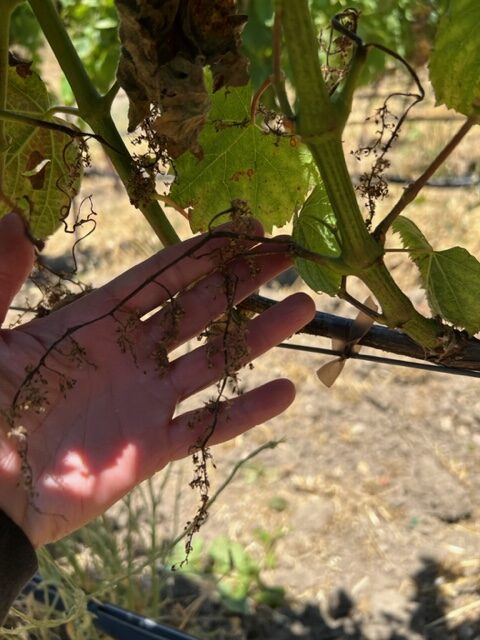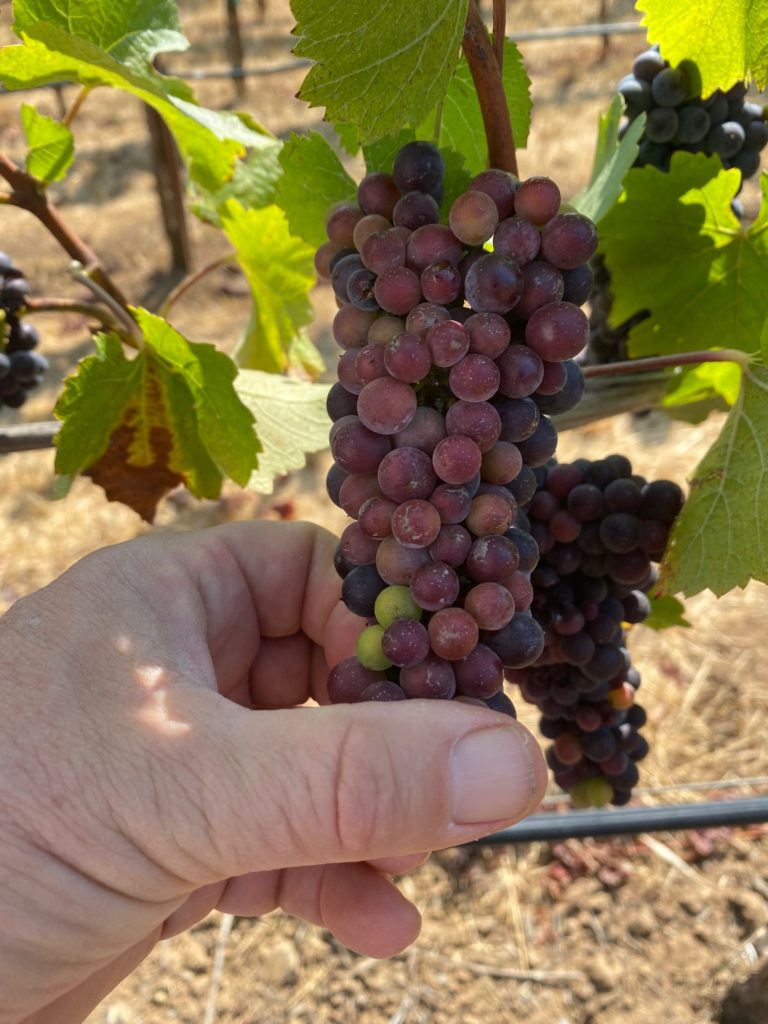No, we aren’t breaking up.
This year has been a little weird. We got a lot of rain and up until recently it’s been markedly cold. How different is it though? One thing I like to keep in mind is that the last few years have been hot and early. Perhaps this is just a normal year and we’ve forgotten what normal looks like.
Although there’s been some argument about its importance, the Winkler Growing Degree Day formula allows us to compare different seasons using the same metric. Growing Degree Days (GDD) are calculated by subtracting the grapevines’ threshold temperature (50°F) from the daily mean temperature. The chart below compares growing degree days from 2014 to July 25, 2023 (today) in Alexander Valley, Sonoma County

That’s pretty different. The average GDDs at this point in the season for the last nine years is about 1650. Currently we are at 1368.
What about in other parts of the state? Here’s a comparison of the last few years in Paso Robles. Granted we don’t have as much data here, but 2023 is still looking behind everything in recent history. As of today this season clocks in at 1540 GDD, while the average for the three previous years is 1870.

What are some of the challenges facing growers in a cold and late year?
Ready, set, no!
One of the main reasons for poor set is early water stress. Thanks to the deluge we got this winter, that wasn’t a big problem. Compared to previous years, canopy growth has been stellar and growth has been relatively even. If your vineyard struggles to fill out the trellis on a non-biblical year, you may be experiencing good or even great fruit set. Congrats.
Where fruit set was bad, it was gnarly. Differences in set this year have illuminated the subtle variations in microclimate. Some vineyards have lost over 50% due to shatter, with colder areas being hit the hardest. And places that sometimes get millerandage (hens and chicks), got it this year.
Fruit set depends on seed development. And seed development depends on a lot of factors. Many of the enzymes responsible for catalyzing the reactions involved in pollen tube formation, fertilization of the gametes, and cell division are functioning optimally between 20-30°C (68-86°). These processes are significantly slowed below 15°C (59°) (Keller, 2020). Some vineyards experienced much colder temperatures this spring.
The cold weather also meant that bloom was extended over a long period of time. If you got a nasty drop in temperature right when a particular vineyard or a particular block was going through bloom, you likely had poor set.
Humidity was also high this spring, and that caused the calyptra or cap to stick to the developing berry. This also limited fertilization as the female gametes were essentially sealed off from the pollen provided by the surrounding anthers. We saw a lot of stuck caps this year and the resulting shatter seems to be variety specific. Syrah for instance recovered in many cases. Pinot Noir did not.

If you don’t have a seed, you’re not going to get a normal grape. The berry may dwarf, creating a “chick” (Some winemakers love these though they can create problems close to harvest). Alternatively, the berry may abort completely. This season we’ve seen entire rachises black and necrotic due to 0% berry development on the cluster.

The silver lining…I guess…is that if you had bad set, there’s probably nothing you could have done about it. Unless your vines are on a very light soil, most vineyards went into this season with a lot more available water than they are used to having. Nutrient uptake was better because of this. Canopies were full. Being on top of your micronutrients doesn’t help if the flowers are cold and wet. The catastrophic examples we’ve been seeing are weather-related. You were either very lucky or you very weren’t.
Then came the heat
And it really wasn’t that bad. Our fear after a spring like this is that suddenly we’d be getting temperatures of over 100° and the vines wouldn’t get a chance to acclimate. The earlier heat damage to fruit occurs, the worse it is. We’ve seen examples before of clusters just shutting down and never fully ripening after an early heat wave. This heat has been, for the most part, gradual. We’re sure to get some more high temperatures this season, but at least the vines are used to it now.

Heat stress is not water stress
Anything over 105° will damage plant tissue. Exposed fruit is usually hotter than ambient temperature. The response of many growers when it starts getting hot is to turn on the water and leave it on. While irrigating in anticipation of a heat event can help keep your leaves happy, your grapes will still burn. This is because leaves can transpire and cool themselves. Grapes have a very limited capacity to transpire and cannot control it because they don’t have functional stomata.
Now maybe you have a lot of nice leaf cover in your fruit zone. There’s only so much cooling via transpiration your leaves can do. If your soil profile is saturated, you can’t just add more water and expect your canopy to get cooler. If it’s 115° a 12-hour-irrigation will do very little to help you. Your canopy will be as happy as it can be, your fruit will still burn, and you’ll lose thousands of gallons of water that will percolate past your root zone and will be wasted.
If you have that kind of water to spare, you’re better off investing in overhead sprinklers or microsprinklers. That will actually cool ambient temperature during heat events.
Conclusion
For those who have fruit, this year looks pretty ok albeit different. I don’t want to jynx anything, so I’ll end by saying that a lot can still go horribly wrong.
Keller, M. (2020). The science of grapevines. Academic press.

